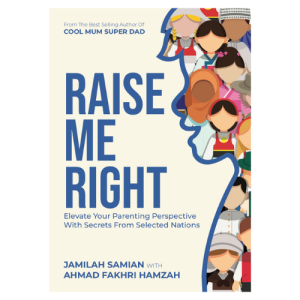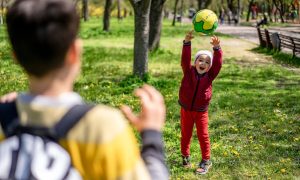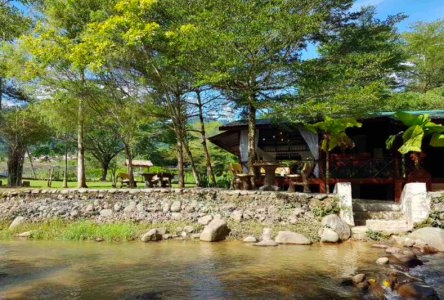 If you find yourself worrying about your young child who often seems to be caught at the wrong place at the wrong time, doing things that could endanger himself, this post is for you.
If you find yourself worrying about your young child who often seems to be caught at the wrong place at the wrong time, doing things that could endanger himself, this post is for you.
Did you know that kindergarten children can be taught benefit-risk analysis – teach them to pause before making risky decisions? How do we teach children to be more aware of the risks and dangers in their paths? Or encourage them to pluck up enough courage to do something they would not otherwise try?
During a visit to Adelaide, Ahmad Fakhri and I spoke to Dr Kaye Colmer, CEO of Gowrie South Australia, who highlighted their values system:
- Relationships – securely attached children
- Rights – children’s own rights and the rights of others on them
- Resilience – young children who aren’t coping are given specific attention
- Emotional Regulation – as a pathway to resilience, children learn to express emotions they have versus emotions that adults might not want them to have (sadness, anger)
Here is a description of how benefit-risk analysis is taught at Gowrie SA.
In our programs, opportunities for these discussions occur daily, whether it is in the moment, when risk becomes visible, when children are actually doing risky things, or during group times when risks are discussed. Key words that are used in conversations with children include ‘benefit’, ‘dangerous’, ‘safe’, ‘hazard’,’ risk’, ‘manage’, ‘plan’, ‘explore’, ‘safety’ and ‘strategies’.
As children’s understanding of risk becomes stronger through these informal conversations, they progress into exploring formal benefit-risk assessments to further strengthen their understanding of assessing risk in collaboration with peers and educators. Educators model and pose questions to provoke the children’s thinking as they explore risks and challenges in their play, asking questions such as, ‘Have you assessed the risks?’, ‘Do you feel safe?’, ‘What things could you check for to keep yourself safe?’, ‘How will you keep yourself safe as you…?’, ‘How do you know the people around you will be safe?’. Educators collaborate with small groups of children to collate their thinking into formally written benefit-risk assessments about common risky play explorations such as tree climbing and building with bricks. In recent play, children were encouraged to contribute to and engage in this process, in their own capable way.
[Ref: http://www.gowriesa.org.au/sites/default/files/reflections-risk-benefit-article.pdf]
As you can see, benefit-risk analysis is being taught in both formal and informal ways.
Trees In Our Midst
On entering the premises, I was taken in by the presence of a tree with a fat trunk which stood firmly in the school grounds. To my pleasant surprise, the tree is featured in Gowrie SA’s video. Connecting with nature is so important for a child’s well-being. Climbing trees comes so naturally to many kids. Growing up, I always felt safe and at peace, perched on the sturdy branches of one of the imposing trees poised in the yard of my family home. I was thankful that my parents never stopped me. I knew that some parents today would not dream of allowing their little ones to get anywhere near such trees for fear of these kids hurting themselves. Children need the freedom to roam free, without a care in the world. The next time you are about to shout ‘Don’t’ to that child of yours who’s about to scale a tree or jump off one, check yourself if a quick benefit-risk analysis might help.

sKIP
A Near Death Experience
As a child I had a knack for bravado. Well, sometimes. A couple of times, it got me into serious trouble. Once, my mother brought me and my elder brother, Latif, to spend some days visiting relatives who lived in a kampong, quite a distance away. A favourite visit as I was head over heels in love with the river that rolled gently behind the wooden houses on stilts.
The next morning, led by my niece and nephew, my brother and I sneaked out. Our innocent hosts brought us to the spot where a dam was, at the river-mouth. As soon as we got there, my niece and nephew jumped into the frothy water bursting out of the dam. For a few minutes they splashed and splurged, beckoning me to join. I dived right in and at once, to my shock, realised I couldn’t keep afloat. I could not swim! If it hadn’t been for Latif’s quick action to pull me out, I would not be alive today.
Neither my brother nor me dared to report my near death to our parents. We had an unspoken understanding that’s how children live. You’re not a child if you do not live in the moment. Spontaneity, the raw thrill of novel experiences, a relish for adventure, even if it wasn’t a daily occurrence. We did what we had to do. Yet as parents now, our perspectives changed overnight. Out of a sense of deep responsibility, we feel obliged to keep our little ones out of danger, the very thing that is so appealing to them. We know full well from experience, thrilling moments for children might spell trouble.
Risk Analysis & Teachable Moment
If you are familiar with the Teachable Moment Method, where parents and educators draw children’s attention to some notable learning points without going into a lecture, you will notice that benefit-risk analysis sits nicely under the wings of the Teachable Moment Method. However, the Teachable Moment Method might suggest that we say something without going into specifics. From experience, I find that many parents out there simply do not know what to say and how to say it, even if they recognise an opportunity to apply the Teachable Moment Method. Where appropriate, benefit-risk analysis helps us to consider what to say to upskill our children into becoming more mature and capable of making wiser, better decisions.
You will see that in teaching benefit-risk analysis, the teacher uses words that have the potential to stretch the children’s vocabulary, stretching young minds to internalise the contexts for each of these words; a step towards preparing them for the real life that is full of risks. . . and rewards if you dare take on the challenge. Notice also that the questions the teachers pose are a mix of open-ended questions and closed questions (Yes/No).
Benefit-Risk Analysis & ‘Just Do It’
Children are naturally highly inquisitive and love adventure. I liked the idea of deliberately planting the seeds of benefit-risk analysis in children’s minds, teaching them to take notice of risky and beneficial situations. Still, benefit-risk analysis to young children must be tempered with plenty of wisdom. How many of us grew up not doing the things we had wanted to do because of over processing the benefits and risks, only to go down the slippery slope of paralysis by analysis? We are so overcome by fear of the risks, we wouldn’t want this mental disability to infect our children.
Be aware of your body language when talking to children about benefit-risk analysis. Aim to strike a balance between raising awareness of the risks, teasing out the benefits, and not overwhelming the child with fear. Going overboard with benefit-risk analysis might steal the spontaneity and magic of childhood.










